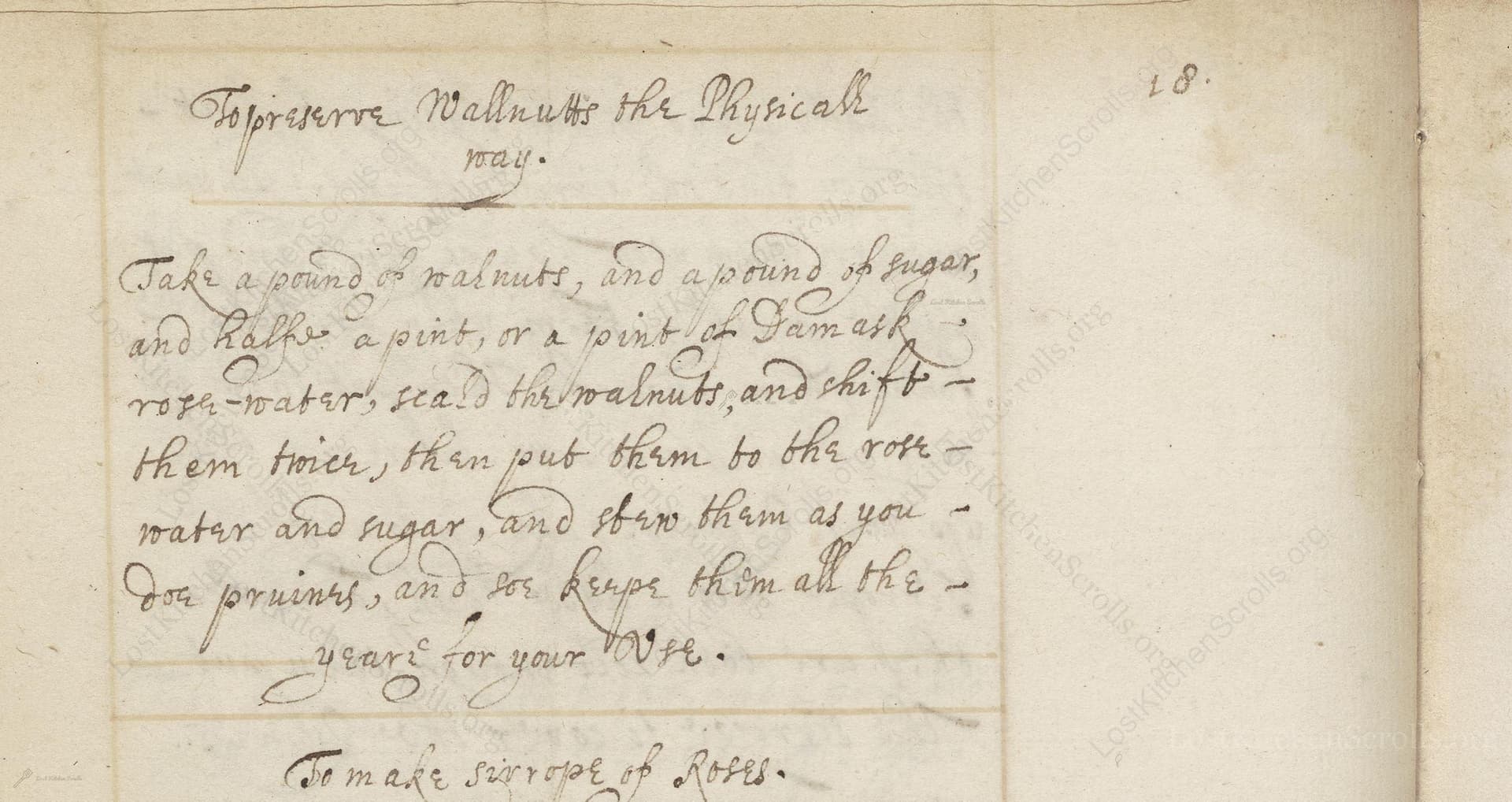To Preserve Walnuts The Physicall Way
From the treasured pages of Receipt book of Sarah Longe
Written by Sarah Longe

To Preserve Walnuts The Physicall Way
"Take a pound of walnuts, and a pound of sugar, and halfe a pint of Damask- rose-water, scald them twice, then shift them into rose - water and sugar, and stow them as you - dow pruins, and soe keepe them all the - yeare for your use."
Note on the Original Text
Recipes from the early 17th century were written without precise measurements, expecting the cook to use experience and intuition. Quantities were given by weight and volume, using common items like 'pound' and 'pint,' but without our modern precision. The language is straightforward yet assumes you know what to do—'scald' meaning to briefly boil, and 'shift them into' meaning to transfer. Spellings like 'halfe' and archaic phrasing are typical, showing how English usage and culinary writing have evolved since the days of Sarah Longe.

Title
Receipt book of Sarah Longe (1610)
You can also click the book image above to peruse the original tome
Writer
Sarah Longe
Era
1610
Publisher
Unknown
Background
A delightful glimpse into early 17th-century kitchens, this collection by Sarah Longe whisks readers through ancestral recipes, cooking tips, and the seasonings that graced the tables of Jacobean England. Prepare to savor the tastes and traditions of times gone by.
Kindly made available by
Folger Shakespeare Library
This recipe comes to us from Sarah Longe, an early 17th-century gentlewoman, written around 1610. At this time, preserving fruits and nuts with sugar was both a luxury and a method of prolonging the shelf life of precious produce. Rose water, especially from Damask roses, was a fashionable ingredient, imbuing preserved foods with an air of refinement and medicinal value, considered 'physicall' for its supposed health benefits. Preserved nuts like these would have graced the tables of the well-off, used both for display and delight at feasts.

Back in 1610, a hearth fire with a large copper or brass cauldron would have been used for scalding and syrup making. Wooden or tin ladles, linen to strain or wipe the nuts, and earthenware or glass jars for storage were all likely at hand. Careful attention was needed to avoid burning the precious syrup and to ensure the jars were clean enough to prevent spoilage.
Prep Time
10 mins
Cook Time
30 mins
Servings
8
We've done our best to adapt this historical recipe for modern kitchens, but some details may still need refinement. We warmly welcome feedback from fellow cooks and culinary historians — your insights support the entire community!
Ingredients
- 1 lb fresh walnuts (young, green walnuts if available)
- 1 lb granulated sugar
- 1 cup Damask rose water (or high-quality culinary rose water as substitute)
Instructions
- To make preserved walnuts the 'physicall way,' start by weighing out 1 pound of fresh walnuts (ideally whole and young, if possible).
- Combine these with 1 pound of sugar and 1 cup of Damask rose water or a high quality rose water as a substitute.
- First, scald (boil briefly) the walnuts in water, drain, and repeat this process once.
- Then, shift the walnuts into a pot with the rose water and sugar.
- Let them gently heat together, allowing the sugar to dissolve fully, forming a syrup to envelop the walnuts.
- Store the walnuts in this rose-scented syrup, much as one would keep dried prunes in syrup.
- Keep the preserved walnuts in clean, airtight jars and use them throughout the year as needed.
Estimated Calories
250 per serving
Cooking Estimates
It takes about 10 minutes to prepare the walnuts and other ingredients, and around 30 minutes to cook them. Each serving has about 250 calories. This recipe makes 8 servings.
As noted above, we have made our best effort to translate and adapt this historical recipe for modern kitchens, taking into account ingredients nowadays, cooking techniques, measurements, and so on. However, historical recipes often contain assumptions that require interpretation.
We'd love for anyone to help improve these adaptations. Community contributions are highly welcome. If you have suggestions, corrections, or cooking tips based on your experience with this recipe, please share them below.
Join the Discussion
Rate This Recipe
Dietary Preference
Main Ingredients
Culinary Technique

Den Bockfisch In Einer Fleisch Suppen Zu Kochen
This recipe hails from a German manuscript cookbook compiled in 1696, a time whe...

Die Grieß Nudlen Zumachen
This recipe comes from a rather mysterious manuscript cookbook, penned anonymous...

Ein Boudain
This recipe comes from an anonymous German-language manuscript cookbook from 169...

Ein Gesaltzen Citroni
This recipe, dating from 1696, comes from an extensive anonymous German cookbook...
Browse our complete collection of time-honored recipes



